For those dreaming of a truly minimalist camping experience, hammock camping can be a wonderful way to experience the great outdoors without the need to lug your tent around. You may be nervous about switching from the safety of your tent to hammock camping and how you can set it up safely.
To hang a hammock you need two sturdy trees or posts that are at least 12 feet apart. Use straps to wrap around the trunks of each tree – ensure they’re tight so your hammock doesn’t sag too much! Attach carabiners to the end loops of the hammock and clip them onto the straps.
Where should you hang your hammock, and how can you do this safely without many trees? And why consider hammock camping at all? Read below to get the full picture before swapping your tent for a hammock.
Why Go Hammock Camping?
With a backpack and tent, you can get as far away from civilization as possible. Why do some campers want to take it to the next level, forgoing their tent for the ultimate exposure of a simple hammock?
For some, a hammock is a more comfortable option.
You aren’t sleeping on the potentially uncomfortable ground, and you don’t need to worry about groundwater seeping into your sleeping space in the event of heavy rain and soaking you and all your gear and clothes.
For the vast majority, however, the fact that hammock camping is so lightweight is the primary draw. There’s no need to add a tent, poles, and all to your kit.
All you need is your hammock, your tarp, added insulation and bug protection, and you have your bed for the night.
You can even find hammocks that promise to offer several of these features already included.
For more information, read my article on tips for hammock camping.
Key Equipment For Hanging a Hammock
To get the best experience from your hammock camping trip, it’s important to bring along the right gear.
This will be hugely important for ensuring your hammock is correctly set up to protect you from the elements.
Without it, even if you hang your hammock securely, you will likely experience an uncomfortable night’s sleep. The bare minimum gear we recommend is the following:
1. Your hammock
Gathered-end hammocks are very prevalent, but there are plenty of other types available which may be more suitable to your needs, such as a flat-lay hammock (which allows you to avoid sleeping at an angle) or a hammock tent (which comes with a mosquito net and rain fly included).
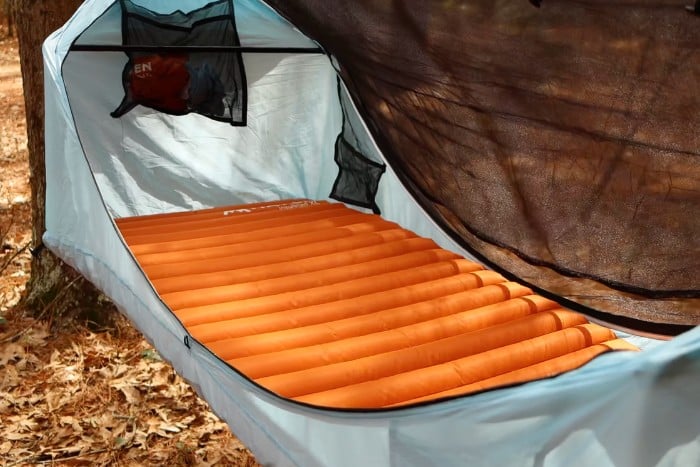
2. Webbing straps
Although it may be tempting to grab some wire, zip cord, or rope from your drawer or garage and attempt to use it to secure your hammock, this is strongly advised against.
All of these materials can cause significant damage to trees and impact their ability to survive. Instead, webbing straps made from polyester or nylon are easily available in good camping stores.
This helps provide a secure attachment for your hammock and prevents damage to your anchor trees.
3. A tarp
While your hammock will give you a comfortable bed for the night, you’ll still be largely exposed to the elements. If it rains, you will experience a very wet night.
Unless your hammock comes with a rain fly, bringing a tarp with you is a simple addition to your kit that can make a huge difference to your comfort levels since it can protect you from the weather to a large extent.
4. Insulating material
This may be unnecessary if you’re hammock camping in hot conditions, but remember that temperatures can dip significantly at night.
If you’re concerned about getting cold overnight, one area to focus on is the underside of your hammock which sees the most significant heat loss.
Add an insulating pad or quilt to your kit, and you’ll see a remarkable reduction in the heat you lose while sleeping.
5. Drip lines
Small but vital, these small lines of cotton can make the difference between a dry and comfortable night’s sleep and a wet and unpleasant experience.
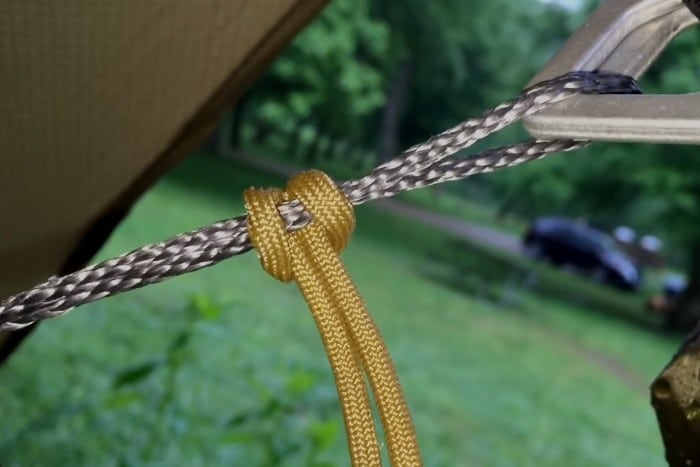
Where to Hang Your Hammock?
As fundamentally important as it is to know how to hang your hammock, where you set up a camp can make the difference between the success and failure of your hammock camping trip.
You should aim to hang your hammock between two trees 12-15 feet apart, which should be ample for an average size hammock.
You may need to use trees with a greater distance between them for larger hammocks.
Although some believe it’s as straightforward as picking two good-sized trees, there’s a lot more nuance to choosing a hammock camping site than it appears at first glance.
Choosing the right trees
Before you commit to your trees for the night, make sure you’ve considered whether they are strong enough to support your weight.
Stay away from trees that have dead branches, as this could signify poor tree health and lead to an uncomfortable mid-sleep tumble if the branches give way.
As well as checking the trees themselves, inspect the area around your proposed hammock site for other potential risks.
Are there many insects indicating a nearby nest that will lead to some crawling bed-fellows?
Similarly, study any poisonous plants that may be common in the area and check your hammock trees for potential irritants.
An area with less surrounding vegetation is better, so stick to frequently used sites if possible.
If you’re not solo camping, remember that despite Instagram shots to the contrary, two separate trees should be used for each hammock.
This is for safety reasons so that the weight load is spread and not focused too much on the same trees.
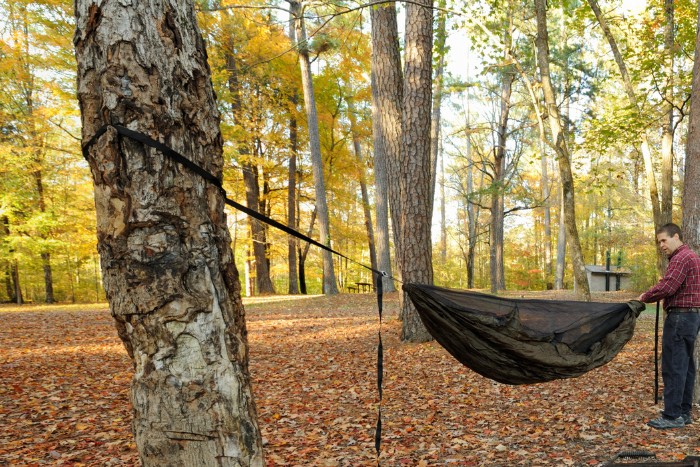
Respecting the environment
As always, whenever we’re venturing into nature, we should always aim to leave a minimal trace and respect the environment we’re in.
Avoid hanging your hammock over any kind of track, trail, or path since not only are these used by hikers, but they may also be important routes for animals.
Similarly, try to stay away from water sources like lakes and rivers. Although it may seem idyllic, setting your hammock up here could disrupt a fragile ecosystem.
How to Hang a Hammock Between Two Trees?
Once carefully selecting your anchor trees, you’re ready to start setting up your hammock. Here are the key steps to ensure you’re strapped in securely for the night.
1. Attach your straps to the anchor trees
Attach your webbing straps to your chosen trees by wrapping around and pulling them so that the straps are tight. Aim to secure them around 6 feet above the ground.
2. Connect your hammock to the straps
Using a carabiner or knot, connect your hammock to the webbing straps so that you have your bed roughly set up for the night.
Adjustments using the carabiner or knot so that your hammock is roughly 1.5 feet off the floor at sitting height.
If you set your hammock up too much higher than this, it will be a struggle to get in and out, which can be particularly annoying if you need a toilet trip in the middle of the night.
You’ll likely need a few tries to see what angle works best for you, but many hammock campers recommend approximately 30 degrees as the most comfortable.
Tightening the connections to flatter the hammock is not recommended since the material will feel less yielding and more uncomfortable for sleeping.
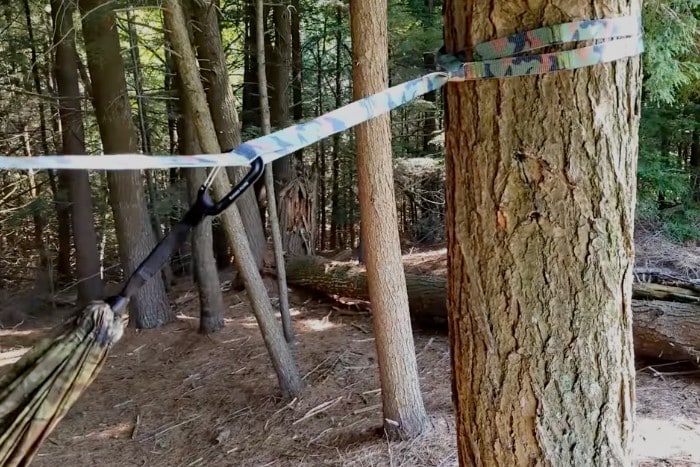
3. Add protection
Now that your hammock is set up and ready to go, you need to ensure that it will be properly sheltered for the night. Attach a line above your hammock by securing both ends to your anchor trees.
Over this, you can place your tarp. After you’ve secured the ends of your tarp to either other trees or the ground, you’ll have created a nicely sheltered environment for your hammock.
Add your insulating layer of a sleeping pad or quilt to your hammock, and you’ll be protected from above and below.
You can find some great camping pad recommendations in my article on the best camping sleeping pads.
4. Make the final touches
Despite the protection of your tarp, rain can drip from your cover, along your straps or chords, to your hammock. This is where your drip lines come in.
Rain getting into your shelter can be prevented by adding drip lines where your webbing meets the ends of your hammock, and it can be as basic as tying a cotton shoelace to these points to redirect the water away from your sleeping space.
Other Kinds of Hammock Camping
Although two-tree hammock camping is certainly the most commonly practiced, you’re not restricted to just this option.
Even if you’re not camping in a densely wooded area, you can still appreciate the excitement of camping with just a hammock between you and nature.
1. One tree hammock camping
If you can find one suitable tree, a couple of options are available to set up a decent hammock campsite, even without a second anchor tree.
The simplest option is to use a large stick as your second anchor by securely digging the stick into the ground and ensuring it is firm enough to stay standing without support.
Then you can use rope or cord and screws to anchor the stick into the ground, with the ropes leading opposite from the site where your hammock will be.
You can use the stick as your second anchor and follow the two tree steps above, as the tension will be enough to keep your hammock securely in place all night.
This method may take some getting used to, and it will be less steady than the two-tree method, but once you’ve been hammock camping for a while, it gives you the freedom to camp in more sparsely forested areas.
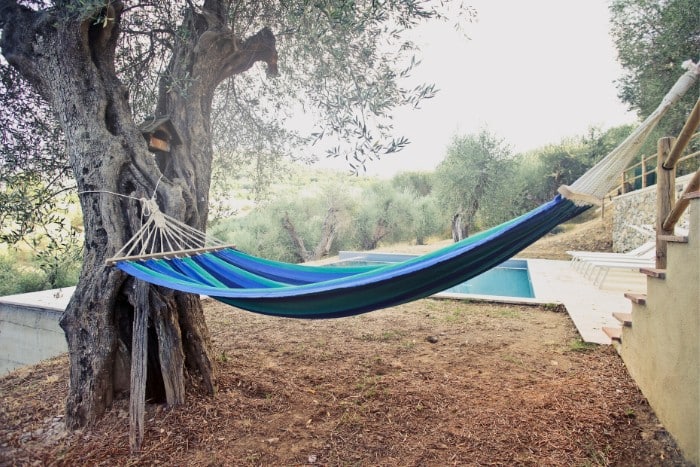
2. Camping with a hammock stand
Alternatively, if you’re new to the hammock camping game or want to explore areas with no trees at all, you can always consider camping with a hammock stand or hammock frame.
The downside to this camping style is that you will have to carry an additional and cumbersome piece of equipment.
Some campers choose hammock camping precisely for its benefits as a minimal-kit adventure style, so the hammock stand won’t be suitable for all.
However, if you want to try hammock camping before you venture into the woods, this may be a great option.
Simply unfold your stand at your designated camp location, ensuring that any ‘lock’ features are securely in place and you can attach the ends of your hammock to the attachment points usually already built into the frame.
There are usually adjustable rings or attachment points to follow the advice above to ensure you have the right angle for a good night’s sleep.
Things to Be Aware of When Hammock Camping
The advice above is a great starting point for those embarking on their first hammock camping adventure.
However, there are still some tips and tricks that experienced hammock campers recommend bearing in mind before you set out on your first trip.
1. You Need A Bug Net
Pack a bug net if you’re camping in warm weather or an area prone to insects, particularly the biting kind.
Although tents tend to be designed with a bug-preventing inner tent, this is not always the case with hammocks, so bring your own and securely fasten it to your tarp line to ensure you don’t spend the night in misery.
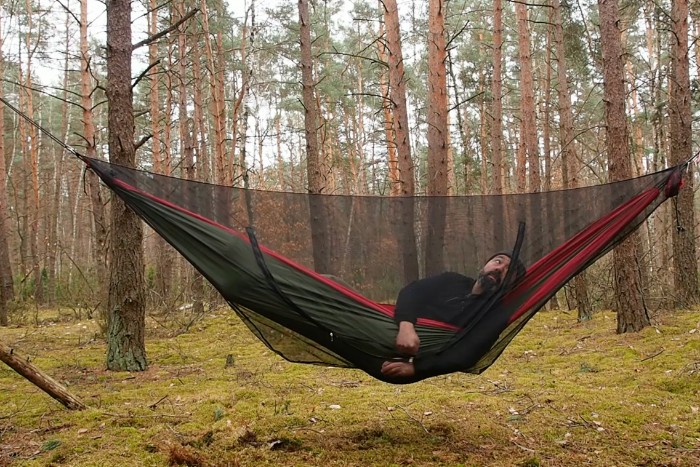
2. Choose An Indoor Hammock
Choose a hammock that is designed for camping outdoors. There are so many hammocks available that it can be difficult to narrow down one that’s right for you.
A hammock you sling up in your yard to sunbathe during summer isn’t going to cut it all night out in the woods.
Many campers recommend investing in quality camping gear since a faulty model can lead to a potentially dangerous nighttime fall.
For some money saving, read my article on when do camping gears go for sale!
3. It Will Be Cold!
Hammock camping feels far colder than tent camping. Don’t underestimate the added protection an inner and outer tent gives you, and prepare to dress warmly and add insulating layers to offset this.
4. Bring A Pillow With You
Use a pillow, a bundle of clothes, or your jacket under your knees to help with your comfort. Using your pillow or clothes as a knee rest can help stop hyper-extension when you first try sleeping in a hammock.
This can help you get comfortable before you get practiced at finding the best sleeping position.
5. Give It A Few Tries
Remember that sleeping in a hammock will take some getting used to. Most of us are generally not used to sleeping at an angle, and the motion can also feel unusual for many.
You may need to try adjusting the angle while you’re sleeping or even try a different hammock or style.
Don’t be disappointed if you don’t get a perfect night’s sleep on your first attempt, as many die-hard hammock campers report that it took them a while to find their sweet spot for getting a great night’s rest.
Final words
Hanging a hammock takes more than just tying your portable bed to two stationary points.
With awareness of what makes a great hammock site, good gear to keep you sheltered, and practice finding the angle that works for you, it won’t be long before you’re a hammock camping convert.
